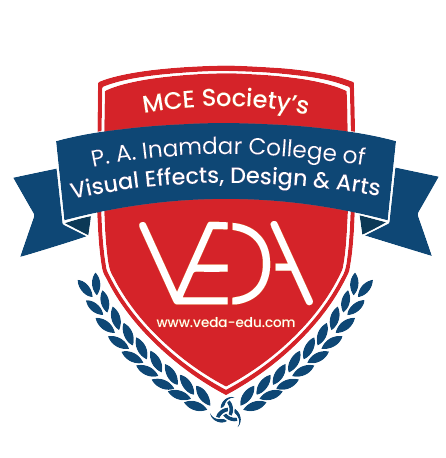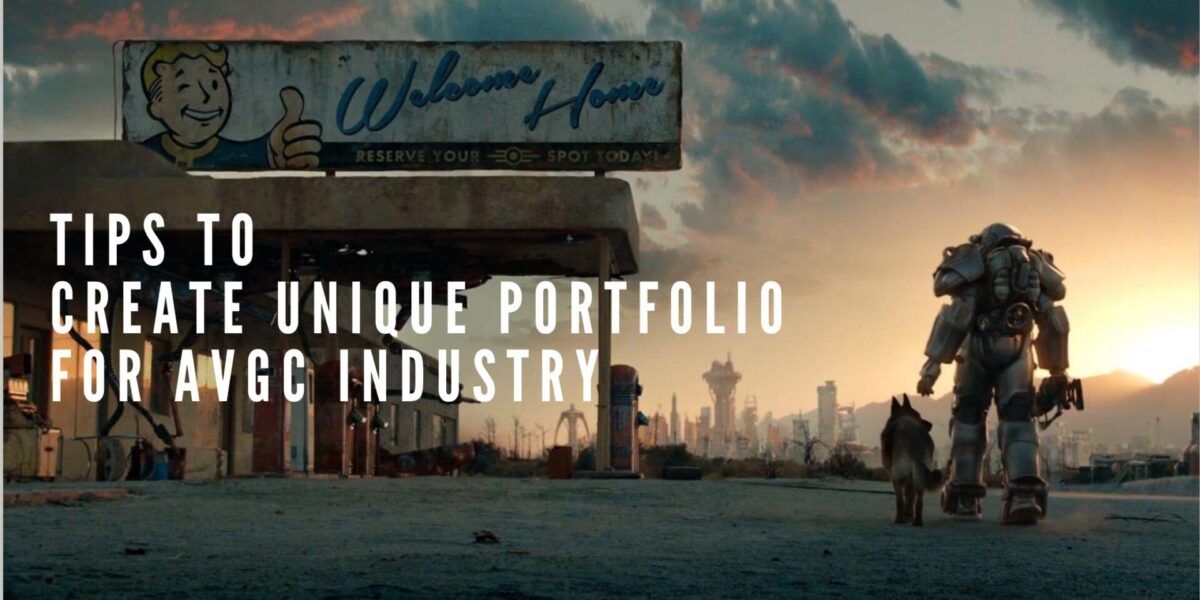In the competitive world of AVGC industry, it can be hard to stand out in the crowd. The best way to make a good first impression is through your portfolio. Those with an outstanding portfolio have a higher chance of capturing the best jobs in the industry.
Here’s what you need to know about designing your animation portfolio to help make a lasting impression.
What is an AVGC portfolio?
An AVGC portfolio (or demo reel) is a compilation of your best and most
relevant work to show potential employers.
Your AVGC portfolio will contain short clips of your work to demonstrate
your skills and style of your choice of department. It may be a combination
of still images and moving animation, showing only the work you’re most
proud of.
Why you need an awesome portfolio?
Your portfolio will have the most influence over whether or not you get the
job, even more so than your resume. Most employers are less interested in
the specifics of your work history and more interested in seeing your artistic
skills in action. A portfolio helps studios to ascertain your skill level, art
style(s), range, and past experience/ roles.
If your portfolio is entertaining and unique to you and your style, even without prior professional experience, it will help you stand out in the sea of
other applicants. And if you’re new to the craft, it could be your ticket to getting your first job in film and games etc.
Features of a stand-out demo reel.
In my experience, the best demo reels:
- Are no more than 2-3 minutes long (1-2 minutes is ideal).
- Include a title card at the beginning and end (with your contact information).
- Show only your best work.
- Show your best-of-the-best work first (to grab their attention)
- If you use music, ensure it doesn’t distract from your work
- Use original animation voice-over and audio if possible
- Present each piece individually, not in a collage style.
- Provide context for each piece of work to highlight your involvement, and include credits where applicable.
Here is a Idea of a good portfolio:
Tips for creating a unique AVGC portfolio
Here are some tips for making a unique portfolio that will get you noticed by employers:
1. Introduce yourself
Be sure to introduce yourself so studios can put a name to the work—you want them to be able to easily refer back to you if you left a good impression.
It’s also important to include contact details like a website or email address so that anyone who comes across your portfolio online knows how to contact you.
2. Include your best work
Your portfolio isn’t a showcase of everything you’ve ever drawn and animated. It should exhibit only your best work. It’s okay to include personal or school projects, especially if you are applying for your first job in film and games, as long as they are relevant and polished (work in progress is okay to include too as long as it’s your best work).
If you’re showcasing a clip with collaborators, be sure to include a note explaining what part of the project you were responsible for.
3. Present your characters
Employers want to see that you can breathe life into your art, design etc. on the screen. They want to see how you do this through artistic touch. They need to see how you can convey story or message through your ART work.
4. Choose quality over quantity
Focus on quality work, not stuffing as much as you can in the portfolio. When choosing your best work for a general portfolio, showcase a range of your favorite or most honed skill sets. For a portfolio aimed at a specific job or studio, tailor the clips to the skills and styles they’re asking for in the job description.
If you can’t decide which clips show your best quality work, make a shortlist and show it to a colleague or mentor who can give you an expert and/or non-biased opinion.
5. Focus on what makes you unique
There are many ways to create an AVGC reel portfolio. You can choose to follow a ready-made template you find online, but employers will likely notice, and it won’t help you be memorable.
Think about what makes your style unique and use your skills to create a portfolio that represents those unique parts. This might be taking a typical challenge and giving it your signature twist or including your own references and using it for your portfolio. For example shoot your own footage scenes to demonstrate how a clip was made using breakdown or before after videos.
6. Keep it short
Recruiters receive stacks of applications to review. You’ll be lucky if you get 30 seconds of their attention, so keep your portfolio as brief as possible.
This is why it’s critical to put your best and most relevant work at the beginning. There is a famous quote by famous animation supervisor “The only time I watch an entire reel is if it’s really, really good, or really, really bad.” -Mark Pullblank
It’s recommended keeping your portfolio under a minute if you don’t have any studio experience and under two minutes if you have a few years of professional animation experience.
7. Match your portfolio to the role
I encourage you to have several versions of your portfolio. Create one generic one that can be used anywhere, then customize your portfolio for
more specific roles you apply for to demonstrate your niche styles and/or industry experience.
For example, if applying for a role as a 3D animator for a video game company, showcase more video game clips rather than examples from a 2D anime series you worked on. Same applies for VFX.
8. Host your portfolio online
Whatever format you present your animation portfolio in, find a reliable online platform to host your content. This makes it easy to share with employers and has the potential for people to find you on Google. You don’t need to create a specialized website, you can use any platform that lets you add content that others can view, such as Youtube, Instagram, ArtStation, and Vimeo. If you do have a website, we recommend uploading
any portfolio videos to YouTube or Vimeo and then embedding them on your website.
Keep in mind that your online portfolio will often be reviewed without you there to explain what’s going on. Be sure to add text that provides additional context—what film your animation is from, what software you
used, what aspects of the clip you were responsible for, etc.
Here is an awesome portfolio example:
9. Importance of showcasing softwares skills in portfolio
In the AVGC (Animation, Visual Effects, Gaming, and Comics) industry, software proficiency is a crucial skill to showcase in a portfolio. It highlights both your technical expertise and your adaptability to industry standards.
Here are some key reasons why showcasing software skills is important in an AVGC portfolio:
1. Demonstrates Technical Proficiency
● Software Mastery: Proficiency in tools like Maya, Blender, Houdini, Unreal Engine, or Adobe After Effects showcases your ability to handle complex tasks, such as 3D modeling, animation, or visual effects creation.
● Efficiency and Workflow: Employers look for individuals who are comfortable with industry-standard software because it leads to faster production times and smoother workflows.
2. Relevance to Job Roles
● Different software tools are used for different roles in the AVGC industry. By listing the right software in your portfolio, you signal your suitability for specific positions. For example:
○ Animators may focus on Maya or Toon Boom Harmony.
○ Game Designers might prioritize Unity or Unreal Engine.
○ VFX Artists might highlight Houdini or Nuke.
○ 2D Artists could focus on Photoshop or Illustrator.
3. Adaptability and Versatility
● Mastery of multiple software platforms shows you can switch between different tasks or projects. It reflects your ability to work on different aspects of a production, from concept art and character design to
final compositing.
4. Industry Expectations
● Standardization: The AVGC industry follows certain software standards. Being familiar with these shows that you are aware of what the industry demands and are ready to hit the ground running.
● Cross-Team Collaboration: Knowing industry-standard software makes collaboration easier across departments, as many projects involve large teams that require consistent file formats and workflows.
5. Continuous Learning and Growth
● Including software tools in your portfolio highlights your ability to continuously learn new tools and updates, a key trait in the fast-evolving AVGC industry. New versions and innovations in software can offer better efficiency or new creative opportunities.
One more example of a good portfolio:
Key Software Tools to Highlight in an AVGC Portfolio:
● 3D Modeling & Animation: Autodesk Maya, Blender, 3ds Max
● Visual Effects: Houdini, Adobe After Effects, Nuke
● Game Development: Unity, Unreal Engine
● Compositing: Nuke, Fusion
● 2D Animation & Illustration: Toon Boom Harmony, Adobe Animate, Photoshop, Illustrator
● Sculpting & Texturing: ZBrush, Substance Painter
By emphasizing software proficiency in your portfolio, you present yourself as a technically capable and versatile candidate who can thrive in the dynamic AVGC industry.
One more examples of how your portfolio should be:


